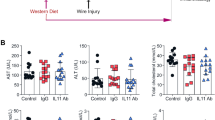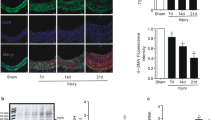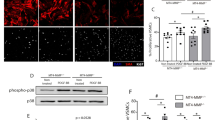Abstract
Adenovirus-mediated gene delivery in animal models of vascular injury has provided insights into the mechanisms underlying vessel wall pathologies. We have previously demonstrated that overexpression of the Gax transcription factor inhibits neointimal formation in rat and rabbit models of arterial injury. Here, we evaluate potential mechanisms for the reduction in stenotic lesion size due to Gax overexpression. At 3, 7 and 14 days after injury the Ad-Gax-infected arteries displayed a marked decrease in medial vascular smooth muscle cell number (3 days, 54% reduction P < 0.01; 7 days, 41% reduction p < 0.003; 14 days, 49% reduction p < 0.02). at 3 days after injury, pcna expression was attenuated in the ad-gax-treated vessels compared with control vessels (65% reduction p < 0.02), indicating a reduction in cellular proliferation. at 7 days and 14 days after injury ad-gax-infected arteries exhibited elevated number of tunel-positive medial vsmcs compared with control-treated arteries (7 days, 9.2-fold increase p < 0.03; 14 days, 17.2-fold increase p < 0.03), indicating an induction of apoptotic cell death. these data suggest that deregulated gax expression induces first cell cycle arrest and then apoptosis in the vascular smooth muscle cells that contribute to the neointimal layer. therefore, the efficacy of this therapeutic strategy appears to result from the ability of the gax transcriptional regulator to modulate multiple cellular responses.
This is a preview of subscription content, access via your institution
Access options
Subscribe to this journal
Receive 12 print issues and online access
$259.00 per year
only $21.58 per issue
Buy this article
- Purchase on Springer Link
- Instant access to full article PDF
Prices may be subject to local taxes which are calculated during checkout




Similar content being viewed by others

References
Campbell JH, Campbell GR . Biology of the vessel wall and atherosclerosis Clin Exp Hypertens 1989 11: 901–913
Geng JY, Libby P . Evidence for apoptosis in advanced human atheroma: colocalization with interleukin-1β converting enzyme Am J Pathol 1995 147: 251–266
Han DKM et al. Evidence for apoptosis in human atherogenesis and in a rat vascular injury model Am J Pathol 1995 147: 267–277
Isner JM, Kearney M, Bortman S, Passeri J . Apoptosis in human atherosclerosis and restenosis Circulation 1995 91: 2703–2711
Gorski DH et al. Molecular cloning of a diverged homeobox gene that is rapidly down-regulated during the G0/G1 transition in vascular smooth muscle cells Mol Cell Biol 1993 13: 3722–3733
Hultgardh-Nilsson A et al. Regulated expression of the Ets-1 transcription factor in vascular smooth muscle cells in vivo and in vitro Circ Res 1996 78: 589–595
Morrisey EE, Ip HS, Parmacek MS . GATA-6: a zinc finger transcription factor that is expressed in multiple cell lineages derived from lateral mesoderm Dev Biol 1996 177: 309–323
Suzuki E et al. The human GATA-6 gene: structure, chromosomal location and regulation of expression by tissue-specific and mitogen-responsive signals Genomics 1996 38: 283–290
Firulli AB et al. Myocyte enhancer binding factor-2 expression and activity in vascular smooth muscle cells Circ Res 1996 78: 196–204
Suzuki E et al. Serum-induction of MEF2/RSRF expression in vascular myocytes is mediated at the level of translation Mol Cell Biol 1995 15: 3415–3423
Walsh K, Perlman H . Molecular strategies to inhibit restenosis: modulation of the vascular myocyte phenotype Semin Intervent Cardiol 1996 1: 173–179
Song K, Wang Y, Sassoon D . Expression of Hox-7.1 in myoblasts inhibits terminal differentiation and induces cell transformation Nature (Lond) 1992 360: 477–481
Castrillo JL, Theill LE, Karin M . Function of the homeodomain protein GHF1 in pituitary cell proliferation Science 1991 253: 197–199
Dear TN et al. The Hox11 gene is essential for cell survival during spleen development Development 1995 121: 2909–2915
Xiong WC, Montell C . Defective glia induce apoptosis in the repo visual system of drosophila Neuron 1995 14: 581–590
Quaggin SE, Yeger H, Igarashi P . Antisense oligonucleotides to Cux-1, a cut-related homeobox gene, cause increased apoptosis in mouse embryonic kidney cultures J Clin Invest 1997 99: 718–724
Marazzi G, Wang Y, Sassoon D . Msx2 is a transcriptional regulator in the BMP-4 mediated programmed cell death pathway Dev Biol 1997 186: 127–138
Weir L et al. Expression of GAX, a growth-arrest homeobox gene, is rapidly down-regulated in the rat carotid artery during the proliferative response to balloon injury J Biol Chem 1995 270: 5457–5461
Smith RC et al. p21CIP1-mediated inhibition of cell proliferation by overexpression of the gax homeodomain gene Genes Dev 1997 11: 1674–1689
Perlman H et al. Bax-mediated cell death by the Gax homeoprotein requires mitogen-activation but is independent of cell cycle activity EMBO J 1998 17: 3576–3586
Maillard L et al. Percutaneous delivery of the gax gene inhibits vessel stenosis in a rabbit model of balloon angioplasty Cardiovasc Res 1997 35: 536–546
Guzman RJ et al. In vivo suppression of injury-induced vascular smooth muscle cell accumulation using adenovirus-mediated transfer of the herpes simplex virus thymidine kinase gene Proc Natl Acad Sci USA 1994 91: 10732–10736
Ohno T et al. Gene therapy for vascular smooth muscle cell proliferation after arterial injury Science 1994 265: 781–784
Simari RD et al. Regulation of cellular proliferation and intimal formation following balloon injury in atherosclerotic rabbit arteries J Clin Invest 1996 98: 225–235
Sata M et al. Fas ligand gene transfer to the vessel wall inhibits neointima formation and overrides the adenovirus-mediated T cell response Proc Natl Acad Sci USA 1998 95: 1213–1217
Clowes AW, Reidy MA, Clowes MM . Mechanisms of stenosis after arterial injury Lab Invest 1983 49: 208–215
Wei GL et al. Temporally and spatially coordinated expression of cell cycle regulatory factors after angioplasty Circ Res 1997 80: 418–426
Perlman H, Maillard L, Krasinski K, Walsh K . Evidence for the rapid onset of apoptosis in medial smooth muscle cells following balloon injury Circulation 1997 95: 981–987
Clowes AW, Reidy MA, Clowes MM . Kinetics of cellular proliferation after arterial injury. I: Smooth muscle cell growth in the absence of endothelium Lab Invest 1983 49: 327–333
Stratford-Perricaudet LD, Makeh I, Perricaudet M, Briand P . Widespread long-term gene transfer to mouse skeletal muscles and heart J Clin Invest 1992 90: 626–630
Columbel M, Olsson CA, Ng P, Buttyan R . Hormone-regulated apoptosis results from re-entry of differentiated prostate cells on to a defective cell cycle Cancer Res 1992 52: 4313–4319
Author information
Authors and Affiliations
Rights and permissions
About this article
Cite this article
Perlman, H., Luo, Z., Krasinski, K. et al. Adenovirus-mediated delivery of the Gax transcription factor to rat carotid arteries inhibits smooth muscle proliferation and induces apoptosis. Gene Ther 6, 758–763 (1999). https://doi.org/10.1038/sj.gt.3300893
Received:
Accepted:
Published:
Issue Date:
DOI: https://doi.org/10.1038/sj.gt.3300893
Keywords
This article is cited by
-
CRCT1 regulated by microRNA-520 g inhibits proliferation and induces apoptosis in esophageal squamous cell cancer
Tumor Biology (2016)
-
Crosstalk between TGF-β/Smad3 and BMP/BMPR2 signaling pathways via miR-17–92 cluster in carotid artery restenosis
Molecular and Cellular Biochemistry (2014)
-
Transcription factor and kinase-mediated signaling in atherosclerosis and vascular injury
Current Atherosclerosis Reports (2006)
-
Characterization of Mesenchyme Homeobox 2 (MEOX2) transcription factor binding to RING finger protein 10
Molecular and Cellular Biochemistry (2005)
-
Effect of percutaneous adenovirus-mediated Gax gene delivery to the arterial wall in double-injured atheromatous stented rabbit iliac arteries
Gene Therapy (2000)


